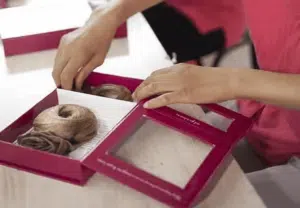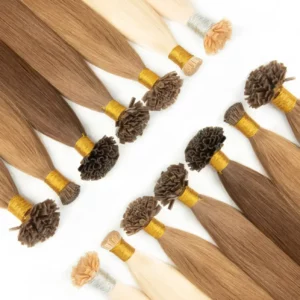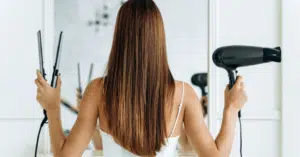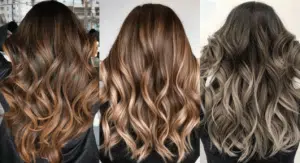You love your new length, but nights feel tricky. Pillows pull, bonds press, and mornings mean tangles. I suggest simple steps that protect the install and keep hair smooth.
Yes, you can sleep comfortably with extensions. I suggest you brush gently, secure hair in a loose low style, use a silk pillowcase or bonnet, and avoid wet hair. Then follow method-specific tips.
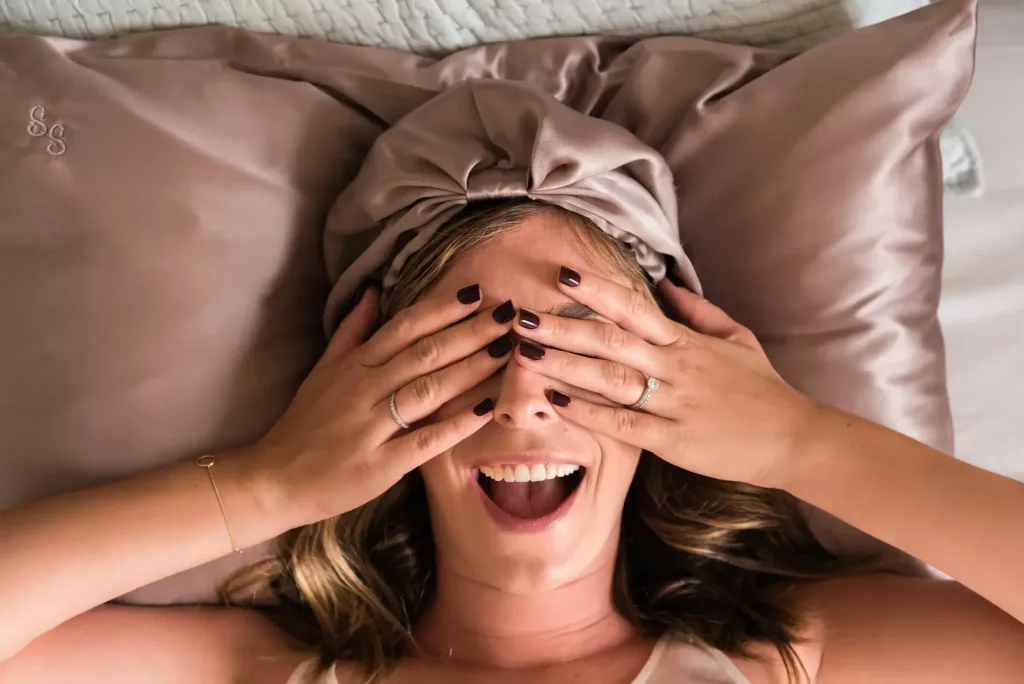
I suggest a short routine you can repeat every night. Dry the base, detangle from ends to roots, separate rows with fingers, and secure a soft low braid. The rest of the guide shows method-by-method steps.
Can you sleep with extensions in?
Nights can cause stress. Many worry about snapping strands or loosening bonds. I suggest one simple checklist that works the same way every night.
Yes. I suggest you detangle gently, dry hair fully, and secure it in a soft low braid or two pigtail braids. Sleep on silk or satin. Keep bonds flat and avoid tight ponytails.
I suggest a four-step flow: dry, detangle, secure, and soften. Dry means do not let damp roots touch the pillow. Water weakens keratin, tape adhesive, and thread tension. Detangle means brush from ends to mid-lengths to roots with a loop or soft-bristle brush. Do not yank at bonds. Separate rows with fingers so no hair crosses over anchor points. Secure means choose a style that spreads weight and limits friction. A single loose low braid fits most installs. Two low pigtail braids are better for dense or very long sets. A low pineapple suits curls, but keep it low so it does not press on bonds. Soften means reduce friction with silk or satin for the pillowcase or a bonnet. Cotton drags on cuticles and causes matting. Silk lets strands glide. Also think about bond direction. With hand-tied or genius wefts, let hair fall in the same direction as the row before braiding. With tape-ins, keep the adhesive sandwiches flat and do not twist near the scalp. With keratin tips, avoid sharp bends. With beaded installs, keep beads aligned; do not sleep in a topknot that torques anchors.
| Step | What to do | Why it matters |
|---|---|---|
| Dry | Blow-dry roots and bonds 100% | Damp bonds weaken and tangle |
| Detangle | Brush ends → mids → roots | Less breakage and knots |
| Separate | Run fingers under rows | Stops base matting |
| Secure | Loose low braid or pigtails | Spreads weight, cuts friction |
| Protect | Silk pillowcase or bonnet | Smooth cuticle, less frizz |
Is sleeping with extensions uncomfortable?
Fresh installs can feel tight for a day or two. A bead or bond may feel like a small pebble under your head. I suggest simple changes that lower pressure fast.
Mild tenderness for 24–72 hours can be normal. I suggest low braids, back or side sleeping, and silk pillows. Pain beyond three nights needs a quick tension or placement check.
Comfort depends on tension, placement, and pillow friction. New weight can cause light scalp sensitivity that fades within a few nights. If it lasts longer, suspect over-tight sections or anchors near pressure points where your head meets the pillow. I suggest reducing pressure in two ways. First, switch to a loose low braid or two low pigtails to spread weight and keep the base flat. Second, adjust the pillow setup. A silk pillowcase is the baseline. If a bond still feels prominent, slide a small towel under the case to create a soft channel so the bond does not carry weight. Track symptoms. A dull, general tenderness is typical on nights one to three. Sharp, pinpoint pain or persistent redness is not typical. That can mean an anchor is too tight, a bead is pinching, or a keratin tip sits on the scalp. Ask for a quick adjustment. Also keep the base clean and dry. Sweat and product near bonds can cause itch that leads to scratching and friction. Cleanse gently along the scalp line and dry fully before bed.
Sleeping in clip in extensions?
Clip-ins are easy for daytime. Nighttime is different. Clips add pressure at a few points. I suggest a safer habit for sleep.
Do not sleep in clip-ins. Remove them to avoid traction, seam bending, and tangles. If you must nap, remove upper rows, keep one light low row, and use silk protection.

Clip-ins are temporary by design. The clips grip hair at several points. That works for a short day. Sleep adds many hours of rolling and friction. This can cause traction near the clips, bend the weft seam, and tangle the clip teeth into natural hair. I suggest you remove clip-ins before bed, brush them, close each clip, and store them flat. If a short travel nap is unavoidable, use only one narrow row at the very low back, secure natural hair in a loose low braid, and wear a silk bonnet. Never stack rows at night. Never sleep in long, heavy clip-in sets. Care after removal extends life. Brush from tips to roots, close clips, and lay wefts on a hanger or in a satin bag. For human hair sets, apply a tiny amount of light serum on mid-lengths to ends, not at the clip base. Wash weekly with gentle care, detangle, and dry fully.
| Night routine for clip-ins | Why |
|---|---|
| Remove all rows | Prevent traction and seam stress |
| Brush and close clips | Avoid fabric snags and bent teeth |
| Store flat in satin bag | Lower friction and dust |
| Silk case or bonnet for your hair | Protects cuticle while you sleep |
How to sleep with sewn in hair extensions?
Sewn-in rows feel secure, but stitching near pillows can rub. I suggest a pattern that keeps rows flat and bases clean.
Keep rows dry, separate each row with fingers, and braid low. Use silk, avoid topknots, and cleanse the scalp line as needed to reduce itch and friction.

Sewn-in wefts, whether hand-tied, genius, or machine, sit along braided or beaded foundations. Friction collects at those lines during sleep. Focus on base care and row alignment. Before bed, lift each row gently with fingers to ensure no neighboring hair loops over the stitch line. Detangle from ends upward. Finish with a single loose low braid, or two low braids for very thick installs. Avoid high ponytails and topknots at night. These styles hinge the row and increase tension at anchor points. A low braid keeps everything aligned with gravity. For extra glide, mist a light leave-in on mid-lengths to ends. Keep products off the base. Scalp care matters. Sweat and product buildup can create itch that leads to scratching and friction. Use a nozzle bottle to apply a gentle cleanse along the scalp between rows when needed, then dry the base 100%. Moisture trapped under a row raises friction and can weaken threads. Check row edges in the morning. If a section feels tight or raised, mark the spot and book a quick adjustment.
| Sewn-in sleep rules | Details |
|---|---|
| Keep base dry | Blow-dry rows fully after wash days |
| Separate rows | Finger-lift to prevent cross-matting |
| Low, loose braids | Reduce hinge tension on stitches |
| Silk pillowcase or bonnet | Lower nightly abrasion |
| No oils at base | Oils relax thread and attract dust |
How to sleep with tape in extensions?
Tape-ins are flat and light, but adhesive reacts to moisture and torque. I suggest a setup that keeps sandwiches sealed.
Sleep only with fully dry hair. Keep braids loose and low. Avoid twisting near the tape tabs. Use silk or satin. Brush tabs gently while stabilizing with your hand.

Tape-ins rely on a pressure-sensitive adhesive held by two flat tabs. Night risks are moisture, torque, and residue at the edges. Do not go to bed with damp roots. Direct the dryer from roots down to keep tabs flat. Avoid heavy oils near the tapes, especially citrus or alcohol-heavy products. Choose a loose low braid that does not twist the tab area. If a tab bends while gathering hair, stop and reposition. Use soft, fabric-covered elastics. Tight elastics crease tabs and may lift corners. When brushing, place your hand over the tab, brush below it first, then glide gently at the roots with a soft brush. Do not hook the brush under the tab line. In the morning, check for lifted edges. Do not pick. Ask for a quick re-tape, since small lifts collect lint and grow. Keep care products on mid-lengths to ends only.
| Tape-in do | Tape-in avoid |
|---|---|
| Dry roots before bed | Sleeping with damp hair |
| Loose low braid | High topknot or tight ponytail |
| Silk pillowcase | Rough cotton that drags tabs |
| Hand on tab while brushing | Tugging under adhesive line |
| Light mid-length serum | Oils near adhesive |
How to sleep with keratin hair extensions?
Keratin tips are secure and discrete, but small resin bonds can press on pillows. I suggest moves that remove hotspots.
Keep bonds flat with a low braid. Do not bend tips sharply. Use silk. Dry roots fully and brush under the bonds with a loop brush to prevent nesting.
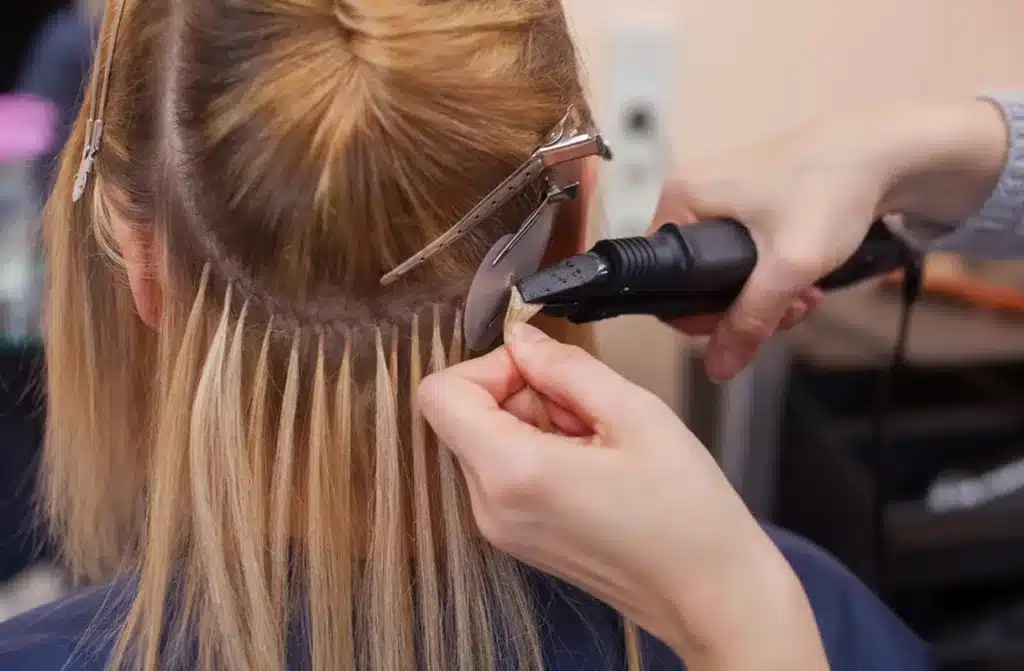
Keratin tips, also called U tip or K tip, bond small sections with resin. Bonds should sit close to the scalp without touching it. At night, avoid positions that fold a line of bonds against the pillow. A low braid controls direction. For very long sets, two low braids balance weight. If a bond line sits under a favorite sleep spot, change sides or use a soft travel pillow to create a channel so bonds do not bear weight. Reduce friction with silk or satin to prevent small hairs around each bond from lifting into “nesting.” Brushing is micro work. Use a loop or soft brush. Hold the hair, brush below the bond first, then glide over the top. Do not saw across the bond line. On wash days, dry bonds first with focused airflow. Damp resin does not fail at once, but repeated flex while moist can loosen encapsulated strands with time.
| Keratin tip checklist | Reason |
|---|---|
| Low braid, no topknot | Prevents sharp bond bends |
| Silk pillow or bonnet | Limits micro-friction |
| Dry bonds first | Keeps resin clean and stable |
| Brush below then above | Avoids catching on bonds |
| Care on mid-lengths | Keeps base free of buildup |
How to sleep with beaded extensions?
Micro-beads are light, but metal rings can press in certain spots. I suggest steps that avoid pinching.
Keep beads aligned, braid low, and use silk. If one bead pinches when you lie on it, change sleep side or ask for repositioning. Do not sleep in tight buns.

Beaded or micro-ring extensions anchor with small rings that clamp a strand or weft. Sleep comfort depends on bead alignment and your sleep position. Low braids encourage beads to lie flat with the hair flow. High ponytails or tight buns torque rings and increase pressure. Before bed, run two fingers along each row and feel for rotated beads. If you find one, lay it back in line with the row. If the same spot hurts each night, mark the location and request a quick adjustment. Often moving a bead a few millimeters solves the issue. Keep the base clean and dry. Sweat and residue around rings cause itch. Use a nozzle bottle to apply a gentle cleanse at the scalp when needed, rinse carefully, and dry the base. In the morning, separate any strands that looped under a ring. Brush from ends to mids to roots, keeping the touch light near beads.
| Beaded do | Beaded avoid |
|---|---|
| Low, loose braids | Tight buns that torque rings |
| Silk pillow or bonnet | Rough cotton that snags |
| Align beads with fingers | Sleeping on rotated beads |
| Dry base fully | Damp roots overnight |
How to relieve pain from hair extensions overnight?
Pain ruins sleep and confidence. I suggest fast relief for tonight and a plan for tomorrow.
Switch to a looser low braid, use silk, and change sleep side. Add a soft travel pillow channel. If pain persists beyond 72 hours, request a tension adjustment.

Night pain usually comes from three sources: over-tight anchors, pressure on one bond line, or friction at the base. The fixes match those causes. Reduce pull with a looser low braid that starts below the bonds, not at the bonds. Change how the head meets the pillow. Slide a small towel under the pillowcase to form a channel so bonds do not carry weight. Use a soft travel pillow for side-sleeping. Cut friction with silk or satin. If tenderness began on day one, expect relief within two or three nights as hair adapts. If pain lasts longer, ask for a quick adjustment. Move a bead, change a stitch, or replace a tape that sits wrong. Early adjustments are quick and protect natural hair. Look for signs of inflammation. Persistent redness, burning, or small pustules need professional attention and a product review. Sometimes the scalp reacts to a formula rather than the method. Switch to a gentle, fragrance-free cleanse and dry the base fully after each wash.
| Symptom | Tonight’s step | Next step |
|---|---|---|
| Local sharp pain | Looser braid, channel pillow | Adjust or move the anchor |
| General tightness | Silk, side change | Re-check row tension |
| Itch at base | Gentle cleanse, dry | Review products, soothing spray |
| Redness or bumps | Stop irritants | Professional check as soon as possible |
My opinion
I suggest treating sleep care as the main factor that protects extensions. Day styling looks exciting, but night friction and moisture cause most issues. Keep the routine short and repeatable. Dry the base. Brush with control. Secure a low, soft braid. Use silk as the standard, not the luxury. If tenderness persists, request an adjustment. Comfort is not a bonus; it is a health signal. These habits protect bonds, keep cuticles flat, and save time every morning across all methods.
FAQ
Can I sleep with wet hair extensions?
No. I suggest drying the base and bonds 100% before bed. Moisture weakens bonds and increases tangles.
What is the best hairstyle for sleeping with extensions?
A loose low braid or two low pigtail braids. They spread weight and limit friction.
Do I need a silk pillowcase or a bonnet?
Choose at least one. A silk pillowcase helps a lot. A bonnet adds more protection for long sets.
How often should I detangle at night?
Every night. Brush ends to mids to roots. Separate rows with fingers before securing.
Is it normal for new extensions to hurt at night?
Mild tenderness for 24–72 hours can be normal. Pain beyond that needs a tension check.
Can I sleep in clip-in extensions?
I do not suggest it. Remove them to prevent traction and seam stress.
What products should I avoid at the base?
Heavy oils, strong alcohol, and adhesive solvents near bonds. Keep care on mid-lengths to ends.
What if I sweat at night?
Cleanse the scalp line when needed and always dry the base fully before the next sleep.
Conclusion
I suggest a simple rule: dry, detangle, secure, and soften. Repeat nightly and extensions will last longer and feel better.
Hibiscus Hair Manufacturer has been dedicated to producing high-quality hair extensions for 25 years and is a recognized leader in the industry. If you are interested in finding a reliable hair extensions supplier and wholesale for your brand, please visit our website for more information:
HOME

